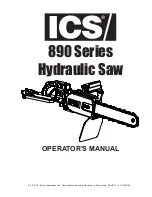
20
Tracking
Figure 32.
Blade centered on wheel.
Tracking the blade means positioning it on the
wheels so it will not come off during operation.
This is usually done by adjusting the tilt of the
upper wheel.
Blade tracking is one of the most important
adjustments you can make for optimal perfor-
mance of your bandsaw. A properly tracked
blade produces very little vibration and heat,
and reduces the chance of binding and wander-
ing when cutting.
There are two ways to track the blade on your
bandsaw:
Center tracking
and
coplanar track-
ing
. Always make sure that your blade is ten-
sioned to the degree that it will be used during
operation before adjusting tracking.
To track the blade using center tracking:
1.
With the bandsaw
unplugged
from the
power source, open the wheel covers. Move
the guide blocks and rear support bearings
away from the blade.
2.
With one hand on the tracking knob (see
“Location of Controls” in this manual if you
need to identify this), slowly rotate the
upper wheel and watch where the blade
rides on the tire of the wheel. If the blade
gets too close to the edge, you may need to
adjust the tracking knob so it does not come
off when you spin the wheel. Turning the
tracking knob clockwise makes the upper
wheel tilt forward and turning counter-
clockwise makes it tilt backward.
3.
Spin the wheel and turn the tracking knob
in the appropriate direction so the blade
rides as close to the center of the tire as
possible.
See Figure 32.
4.
Readjust the guide blocks and rear support
bearings.
Read the next section for coplanar tracking.
NOTICE
An over-tensioned blade may be the cause
of tracking problems. Adjust to proper ten-
sion prior to adjusting tracking. Excessive
tension will cause the blade to break.
















































